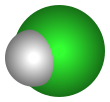Anhydrous hydrochloric acid
|
|
|||
| Names | |||
|---|---|---|---|
|
IUPAC name
Hydrogen chloride
|
|||
| Other names
Hydrochloric acid gas
Hydrochloric gas |
|||
| Identifiers | |||
|
3D model (JSmol)
|
|||
| 1098214 | |||
| ChEBI | |||
| ChEMBL | |||
| ChemSpider | |||
| ECHA InfoCard | 100.028.723 | ||
| EC Number | 231-595-7 | ||
| 322 | |||
| KEGG | |||
| MeSH | Hydrochloric+acid | ||
| RTECS number | MW4025000 | ||
| UNII | |||
| UN number | 1050 | ||
|
|||
|
|||
| Properties | |||
| HCl | |||
| Molar mass | 36.46 g/mol | ||
| Appearance | Colorless gas | ||
| Odor | pungent; sharp and burning | ||
| Density | 1.49 g L−1 | ||
| Melting point | −114.22 °C (−173.60 °F; 158.93 K) | ||
| Boiling point | −85.05 °C (−121.09 °F; 188.10 K) | ||
| 823 g/L (0 °C) 720 g/L (20 °C) 561 g/L (60 °C) |
|||
| Solubility | soluble in methanol, ethanol, ether | ||
| Vapor pressure | 4352 kPa (at 21.1 °C) | ||
| Acidity (pKa) | -3.0; -5.9 (±0.4) | ||
| Basicity (pKb) | 17.0 | ||
|
Refractive index (nD)
|
1.0004456 (gas) 1.254 (liquid) |
||
| Viscosity | 0.311 cP (−100 °C) | ||
| Structure | |||
| linear | |||
| 1.05 D | |||
| Thermochemistry | |||
| 0.7981 J K−1 g−1 | |||
|
Std molar
entropy (S |
186.902 J K−1 mol−1 | ||
|
Std enthalpy of
formation (ΔfH |
–92.31 kJ mol−1 | ||
|
Std enthalpy of
combustion (ΔcH |
–95.31 kJ mol−1 | ||
| Pharmacology | |||
| A09AB03 (WHO) B05XA13 (WHO) | |||
| Hazards | |||
| Safety data sheet | JT Baker MSDS | ||
| GHS pictograms |
 
|
||
| GHS signal word | Danger | ||
| H280, H314, H331 | |||
| P261, P280, P305+351+338, P310, P410+403 | |||
| NFPA 704 | |||
| Lethal dose or concentration (LD, LC): | |||
|
LD50 (median dose)
|
238 mg/kg (rat, oral) | ||
|
LC50 (median concentration)
|
3124 ppm (rat, 1 hr) 1108 ppm (mouse, 1 hr) |
||
|
LCLo (lowest published)
|
1300 ppm (human, 30 min) 4416 ppm (rabbit, 30 min) 4416 ppm (guinea pig, 30 min) 3000 ppm (human, 5 min) |
||
| US health exposure limits (NIOSH): | |||
|
PEL (Permissible)
|
C 5 ppm (7 mg/m3) | ||
|
REL (Recommended)
|
C 5 ppm (7 mg/m3) | ||
|
IDLH (Immediate danger)
|
50 ppm | ||
| Related compounds | |||
|
Related compounds
|
Hydrogen fluoride Hydrogen bromide Hydrogen iodide Hydrogen astatide |
||
|
Except where otherwise noted, data are given for materials in their standard state (at 25 °C [77 °F], 100 kPa).
|
|||
|
|
|||
| Infobox references | |||
Hydrochloric gas
The compound hydrogen chloride has the chemical formula HCl and as such is a hydrogen halide. At room temperature, it is a colorless gas, which forms white fumes of hydrochloric acid upon contact with atmospheric water vapor. Hydrogen chloride gas and hydrochloric acid are important in technology and industry. Hydrochloric acid, the aqueous solution of hydrogen chloride, is also commonly given the formula HCl.
Hydrogen chloride is a diatomic molecule, consisting of a hydrogen atom H and a chlorine atom Cl connected by a polar covalent bond. The chlorine atom is much more electronegative than the hydrogen atom, which makes this bond polar. Consequently, the molecule has a large dipole moment with a negative partial charge (δ−) at the chlorine atom and a positive partial charge (δ+) at the hydrogen atom. In part because of its high polarity, HCl is very soluble in water (and in other polar solvents).
Upon contact, H2O and HCl combine to form hydronium cations H3O+ and chloride anions Cl− through a reversible chemical reaction:
...
Wikipedia



